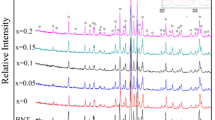Abstract
Small additions of Bi2O3 or bismuth titanate improve the dielectric properties of Ba4.5Nd9Ti18O54 at microwave frequencies. It was found that Bi3+ can replace Nd3+ up to 15 mol%, the limiting composition of solid solution being Ba4.5(Nd0.85Bi0.15)9Ti18O54. At the solid solution limit the temperature coefficient of resonant frequency attains its minimum value. The modified ceramic is distinguished by high permittivity of 99 and a Q-value of 5500. The temperature coefficient of resonant frequency is low, 15 ppm/K. After exceeding the solid solubility limit, additional Bi2O3 concentrates as a Bi-rich phase at the grain boundaries, causing considerable reduction of the Q-value and an increase of τf.
Similar content being viewed by others
References
M. B. Varfolomeev, A. S. Mironov, S. S. Kostomarov, L. A. Golubchova, and T. A. Zolotova, Zh. Neorg. Khim. 33 (4), 1070 (1988).
D. Kolar, S. Gabršcek, B. Volavšek, H. S. Parker, and R. S. Roth, J. Solid State Chem. 38 (1), 158 (1981).
D. Kolar, S. Gabršcek, and D. Suvorov, in Third Euro-ceramics: Properties of Ceramics, edited by P. Durand and J. F. Fernandez (Proc. of Third European Ceram. Soc. Conf. 2, Madrid, Spain, 1993), p. 229.
R. G. Matveeva, M. B. Varfolomeev, and L. S. Il’yuschenko, Russ. J. Inorg. Chem. 29 (1), 17 (1984).
K. Wakino, K. Minai, H. Tamura, J. Am. Ceram. Soc. 67 (4), 278 (1984).
T. Negas, G. Yeager, S. Bell, and R. Amren, in Chemistry of Electronic Ceramic Materials (Proc. of Int. Conf. of Elect. Ceram. Mater., NIST SP 804, Jackson, 1990), p. 21.
D. Kolar, S. Gaberšcek, Z. Stadler, and D. Suvorov, Ferroelectrics 27, 269 (1980).
W. Wersing, in Electronic Ceramics (Elsevier Sci. Pub., 1991), p. 79.
L. P. Mudrolubova, K. E. Lisker, B. A. Rotenberg, T. F. Limarii, and A. N. Borsch, El. Teh., Ser. Radiodetali-Radiokomp. 46 (1), 3 (1982).
J. M. Durand and J. P. Boilot, J. Mater. Sci. Lett., (6), 134 (1987).
T. Itoh and R. S. Rudokas, IEEE Trans., MTT MTT-25 (1), 52 (1977).
D. Kajfez and E. J. Hwan, IEEE Trans., MTT MTT-32 (7), 666 (1984).
M. Valant, D. Suvorov, and D. Kolar, in Electroceramics IV (Proc. of IV Conf. of Electroceram., Aachen, Germany, 1994), Vol. 1, p. 69.
Author information
Authors and Affiliations
Rights and permissions
About this article
Cite this article
Valant, M., Suvorov, D. & Kolar, D. Role of Bi2O3 in optimizing the dielectric properties of Ba4.5Nd9Ti18O54 based microwave ceramics. Journal of Materials Research 11, 928–931 (1996). https://doi.org/10.1557/JMR.1996.0116
Received:
Accepted:
Published:
Issue Date:
DOI: https://doi.org/10.1557/JMR.1996.0116




